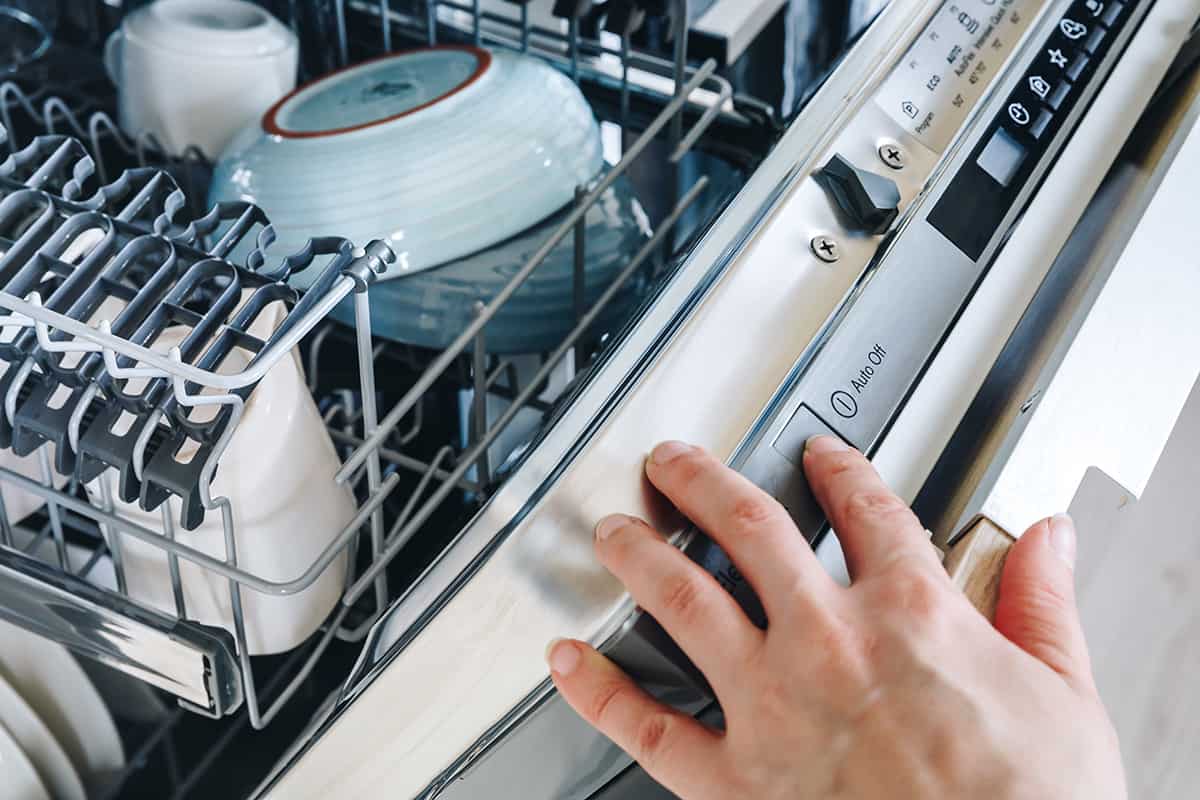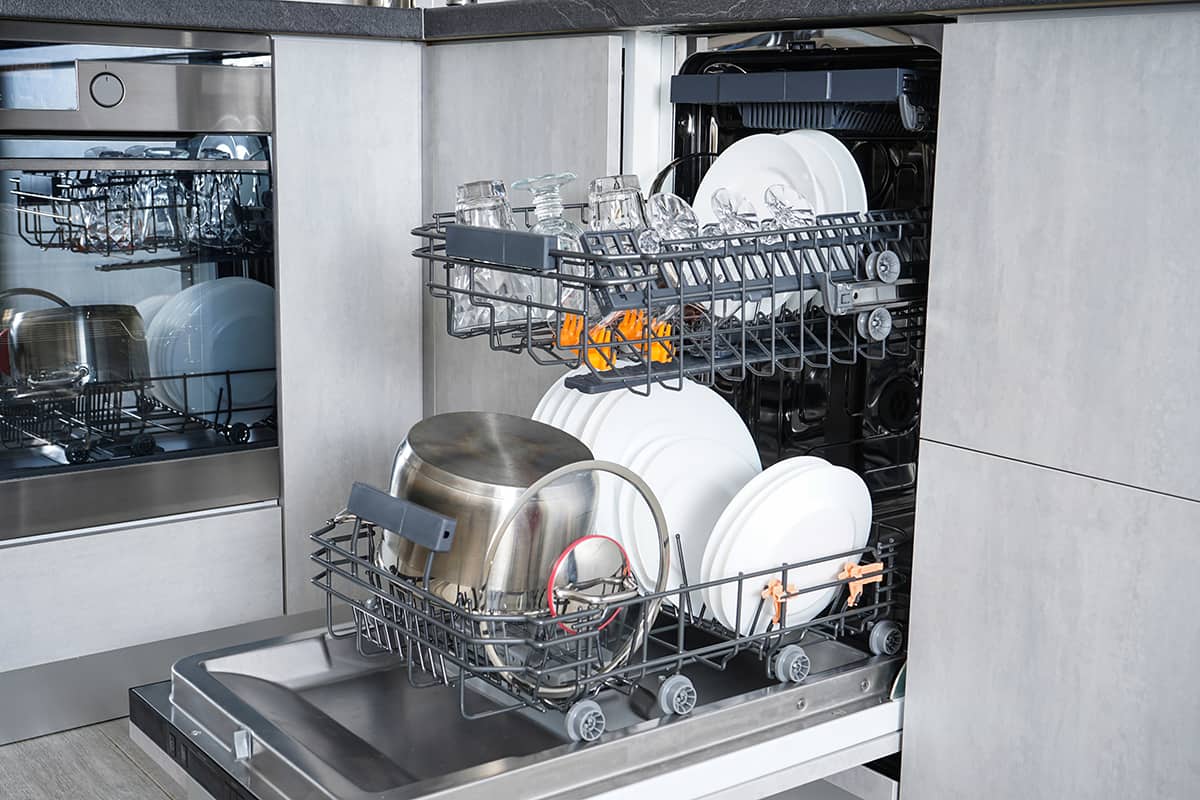A dishwasher makes life fine and dandy until you realize how much maintenance there is. One of the most painstaking maintenance jobs is removing melted plastic from inside a dishwasher. So, when this happens, what should you do?
Plastic glasses and utensils that drop from their compartments and land on the dishwasher’s heating element can create a mess. To get rid of it, place an ice pack on the melted plastic, wait for the plastic to harden, then gently crack the plastic off. You might need a scraping tool to get rid of all the plastic residue.
In this guide, I’ll explain more thoroughly how you can get rid of melted plastic from inside your dishwasher and how to prevent it from happening again in the future.
Why Does Plastic Melt in Dishwashers?
A dishwasher’s main duty is to, well, wash dishes—it’s right there in the name. It does so by introducing heated water and soap to the dishes placed in its dishracks. After multiple cycles, your dishes should come out of the dishwasher squeaky-clean.
However, if you’re a fan of plastic cutlery and drinkware, then you’ve probably had to deal with your fair share of melted plastic. Although plastic usually melts at 212°F (100°C), some commonly used plastics, especially when poured into thin molds, can melt at a much lower temperature. When your dishwasher shoots heated water and the plastic, it may cause some of the material to drip down and land on the bottom of the dishwasher tub.
In other more extreme cases, the pressurized jets of water might have knocked plastic cutlery and drinkware out of position, forcing them downward toward the dishwasher’s heating element. When this happens, you don’t just have to worry about scraping melted plastic off the coils but also ensuring that the heating element is still in tip-top shape.
So, when plastic melts in your dishwasher, what should you do?
How to Remove Melted Plastic from Dishwasher

The first thing to pop into your mind is to probably run another hot-water cycle—e.g., a rinse cycle or a complete wash cycle. This, however, is the last thing you should do. If the plastic has melted onto the dishwasher’s heating coils, you might end up with a foul odor in your kitchen or, worst-case scenario, a broken heating element.
In the event your dishwasher inadvertently melts plastic during a wash cycle, here’s what you’ll need and what you’ll have to do.
- Ice pack or Ziploc bag filled with ice cubes
- Plastic scraping tool
- Nail polish remover
- 3 microfiber cloths
- Dish soap
- Mixing bowl
- Water
Turn the dishwasher off. This should cancel all previously input programs if the dishwasher was in the middle of performing a wash cycle. Wait for about 20 minutes to allow everything to come back down to room temperature.
Unplug your dishwasher. For hardwired dishwashers, you will need to shut off the main breaker that leads to your dishwasher.
Unload your dishwasher. While you can get away with unloading only the bottom rack, it’s a good idea to unload everything to give you better access to the entirety of the dishwasher’s tub.
Locate the melted plastic. Odds are the plastic residue is somewhere at the bottom of the tub or on the heating coils.
Place a frozen ice pack or a resealable bag filled with ice onto the melted plastic residue. Leave the ice pack or bag on plastic for about 20 minutes to give it time to harden. After 20 minutes, remove the ice pack or ice-filled bag.
Use the handle of a spoon or a scaping tool to remove the hardened plastic from your dishwasher carefully. A wooden spoon will work, too. The goal is to remove as much of the melted plastic as possible.
Soak a clean microfiber cloth in acetone nail polish remover and place it on the heating coils of your dishwasher. Let the cloth sit there for about 5 minutes. DO NOT pour acetone into your dishwasher.
Using the same acetone-soaked cloth, scrub the coils until the remaining plastic residue is gone. It might take a bit of elbow grease, but the acetone should make things easier.
Soak another clean microfiber cloth in fresh water and rub the heating coils until they’re completely dry. This step should remove the remaining plastic residue.
Mix 3 droplets of dish soap in a gallon of water and, using another clean cloth, wash the heating coils.
Rinse the coils in a gallon of fresh, clean water before plugging the dishwasher back in and running a test cycle.
How to Stop Plastic from Melting Inside a Dishwasher
The main reason you will find melted plastic in your dishwasher is that you did a poor job arranging your plastic cutlery, dishwasher, and drinkware. Don’t be too concerned; it happens to the best of us. However, it’s important that we learn from our mistakes.
To prevent this from happening again, you should look at the instruction manual to see how to arrange your dishes and cutlery in your dishwasher properly. Make sure all of your spoons, knives, and forks are inside the cutlery basket with their handles pointed upward. That way, pressurized water from the spray arms has less of a chance of knocking the cutlery out, causing them to fall underneath the dishwasher’s heating elements.
When arranging plastic dishes on the bottom rack, make sure you follow the “spike” guides. Use one spike per dish and leave a distance of at least 2 spikes between dishes and bowls. To make sure everything is arranged how it should be, give the top and bottom racks a slight jiggle. Your dishes and cutlery shouldn’t move out of position.
How to Remove Broken Glass from a Dishwasher

Broken glass, like melted plastic, can be a pain in the neck to remove from a dishwasher, but luckily, the solution to get rid of glass shards is quite simple. All you need is a halved potato.
Step 1—Turn off your dishwasher and unplug it from the power source.
Step 2—Unload your dishwasher.
Step 3—Open the dishwasher door and allow it to dry thoroughly.
Step 4—Slice a potato in half lengthwise so that there is more surface area on the fleshy side of the potato.
Step 5—Using thick rubber gloves, grab the skin side of the potato and gently dab the bottom of your dishwasher with the fleshy side of the potato. Do not wipe the inside of the dishwasher with the potato since it might cause glass fragments to scrape the stainless-steel finish.
Step 6—Wash the potato under cold running water and repeat dabbing the bottom of your dishwasher until you’re confident all of the glass fragments are gone.
Step 7—Toss the potato half in the garbage.
Step 8—Remove the filter assembly from your dishwasher and toss the debris in the garbage. Some of the glass shards may be trapped in the mesh filter.
Step 9—Soak the filter assembly and wash it in soapy water. Use gloves while doing this just in case there are any glass fragments stuck to the mesh filter.
Step 10—Reinstall the filter assembly, turn on the dishwasher, and run a rinse cycle.
Step 11—Turn off the dishwasher, remove the filter assembly, and wash it again before reinstalling it inside the dishwasher.
Sure, there are far more steps required to remove glass fragments from a dishwasher than melted plastic, but the risk of cutting yourself is far greater. Exercise the utmost caution when getting rid of glass shards from the tiny cavity of your dishwasher.






